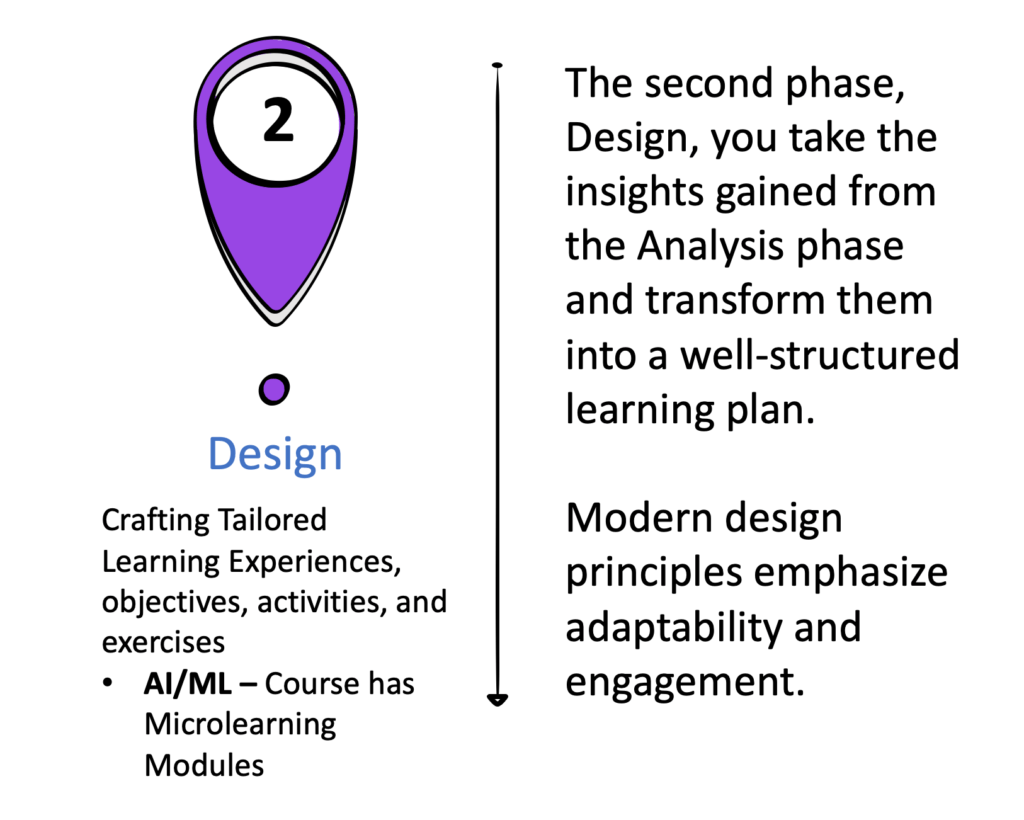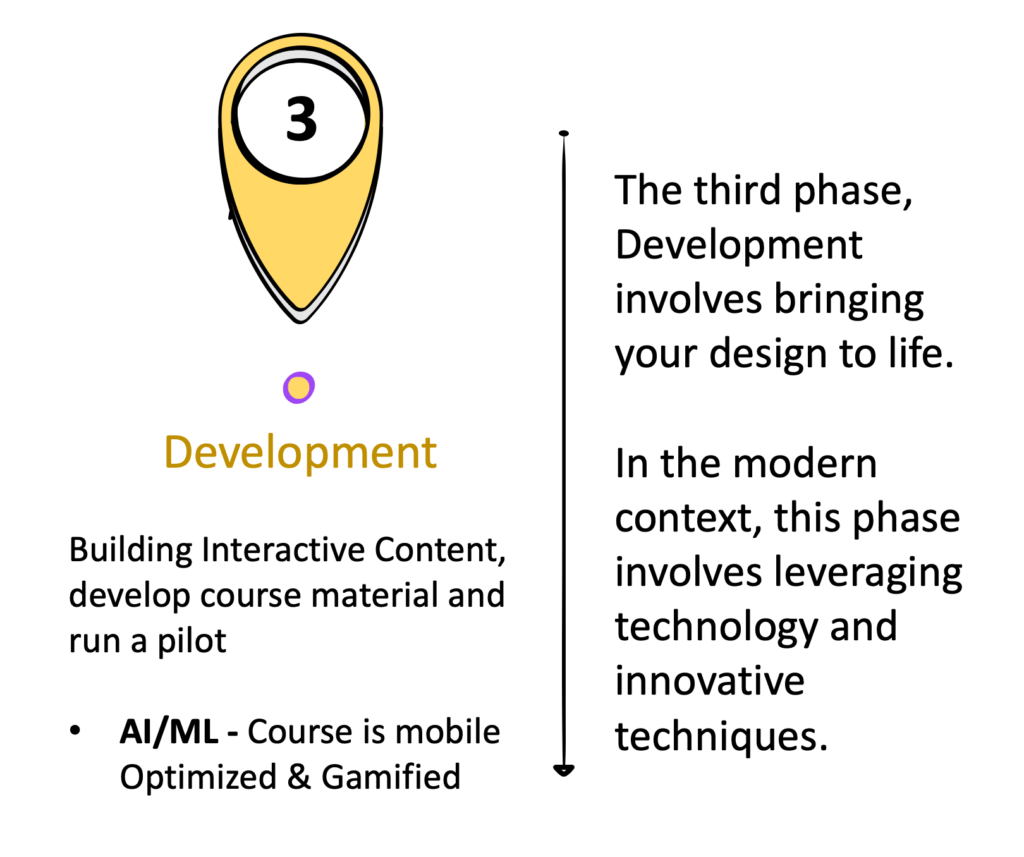In today’s fast-paced digital landscape, the world of learning and development has undergone a significant transformation. Traditional approaches to instructional design, such as the ADDIE (Analysis, Design, Development, Implementation, and Evaluation) model, have had to adapt to keep pace with the demands of the modern learner. To stay competitive and relevant, organizations must consider a fresh perspective on ADDIE. In this article, we explore ten modern considerations that can supercharge your learning design process, integrating the latest AI/ML (Artificial Intelligence/Machine Learning) references for each phase, helping you achieve more effective and engaging training programs.

Analysis (A of ADDIE): Understanding the Modern Learner

1. User-Centric Design
- Reference: How AI Can Improve User-Centric Design
- Utilize AI-powered tools like chatbots and data analytics to gather real-time user feedback. Natural Language Processing (NLP) algorithms can help analyze user responses, providing valuable insights into their needs and preferences.
- Example: Suppose you’re tasked with developing an online course on digital marketing. Before you dive into designing the course, you use AI tools like chatbots to interact with potential learners. These chatbots can collect real-time feedback on what learners expect from a digital marketing course. For instance, the chatbot can ask questions like, “What specific topics in digital marketing are you interested in?” or “How do you prefer to learn—through videos, articles, or interactive quizzes?” The responses collected are then analyzed using Natural Language Processing (NLP) algorithms, which help identify common preferences and expectations among your potential learners. By leveraging AI in this phase, you gain valuable insights that guide your course’s content, structure, and delivery methods. This ensures that your digital marketing course is not only ADDIE based but also user-centric, aligning perfectly with the needs and preferences of your target audience.
Design (D1 of ADDIE) : Crafting Tailored Learning Experiences

2. Microlearning Modules
- Machine learning algorithms can track learner progress and adapt content accordingly. Recommender systems, akin to those used by streaming platforms, can suggest microlearning modules based on individual learner behavior and preferences.
- Example: Once you’ve gathered insights from the Analysis phase, it’s time to design your course. Here’s where AI-driven personalization comes into play. Imagine that you’re creating a series of microlearning modules covering various aspects of digital marketing. Machine learning algorithms analyze user behavior within your course platform. They track which modules learners engage with the most, which quizzes they perform well on, and which topics they struggle with. Based on this data, an AI recommender system kicks in. Similar to how streaming platforms recommend movies based on your viewing history, this system suggests microlearning modules tailored to each learner’s progress and preferences. For instance, if a learner excels in social media marketing but struggles with SEO, the system recommends more advanced social media modules while providing additional resources to strengthen their SEO skills. This dynamic approach to course design ensures that learners receive content that is not only relevant but also adapts to their individual learning journeys leveraging ADDIE model.
Development (D2 of ADDIE): Building Interactive Content

3. Mobile Optimization
- Reference: AI-Driven Mobile Optimization for E-Learning
- Machine learning can predict when and where learners are most likely to engage with content on mobile devices. By analyzing historical data, you can optimize content delivery for maximum impact.
4. Gamification
- AI-driven game analytics can provide real-time feedback on learner performance. Machine learning algorithms can adjust game difficulty levels based on the learner’s skill level, ensuring a personalized and challenging experience.
- Example: In the Development phase, you focus on creating engaging content. Let’s say you’re developing a mobile app to complement your digital marketing course. AI can play a significant role in optimizing the app for various devices. Machine learning models analyze historical data to predict when and where learners are most likely to access your app. For instance, they might find that most learners prefer to study during their morning commute. Leveraging this information, your app can send push notifications at that time, encouraging users to engage with the content. Furthermore, the app can use AI to customize the learning experience. For example, if a user constantly accesses the SEO section of your course, the app can prioritize SEO-related content in their daily recommendations. This level of personalization is achieved marrying ADDIE with AI and ML and it enhances engagement and ensures learners make the most of their mobile learning experience.
Implementation (I of ADDIE): Deploying Learning Resources

5. AI-Powered Personalization
- Reference: The Role of AI in Personalized Learning
- Leverage AI algorithms for content recommendations, similar to how Netflix recommends movies. Personalized content delivery ensures that each learner receives the most relevant material to meet their unique needs.
6. Data-Driven Decision Making
- Machine learning models can analyze learner data at scale, identifying patterns and trends that may not be evident through manual analysis. These insights guide data-driven decision making for continuous improvement.
- Example: When it comes to implementing your course, AI-powered personalization continues to shine. Imagine you’ve integrated AI algorithms into your course platform. As learners navigate through the material, the system tracks their interactions and collects data. This data is then used to provide AI-driven personalization. Learners receive recommendations for additional resources, such as articles, videos, or case studies, based on their progress. These recommendations are not generic but rather tailored to each learner’s specific needs and challenges. For example, if a learner is struggling with email marketing concepts, the system can suggest supplementary video tutorials on email marketing best practices. This AI-driven personalization clubbed with ADDIE model ensures that learners receive timely support and resources to enhance their understanding.
Evaluation (E of ADDIE): Measuring Success & Iterating

7. Collaborative Learning Environments
- AI-powered collaboration tools can facilitate discussions and group work. Machine learning algorithms can identify valuable contributions, making it easier to recognize and reward collaborative efforts.
8. Accessibility and Inclusivity
- AI-driven accessibility tools can automatically generate alternative formats, such as audio descriptions or transcripts, to ensure that content is accessible to all learners, including those with disabilities.
9. Continuous Learning Pathways
- Reference: AI-Driven Continuous Learning Pathways
- Machine learning can create personalized learning pathways based on individual progress and goals. Adaptive learning systems adjust content and assessments to match the learner’s evolving needs.
10. Feedback Loops
- Reference: AI-Enhanced Feedback Loops in E-Learning
- Natural Language Processing (NLP) can analyze learner feedback for sentiment and trends. Machine learning models can identify common issues and suggest improvements, streamlining the feedback loop.
- Example: In the Evaluation phase, AI continues to play a crucial role in measuring the effectiveness of your course. Let’s consider the collaborative learning environment within your digital marketing course. AI-powered collaboration tools track learner interactions within discussion boards and group projects. Machine learning algorithms identify the most active and productive contributors. This data helps instructors recognize and reward learners who actively participate and contribute valuable insights to the community. Additionally, AI can analyze feedback provided by learners through surveys and discussions. Natural Language Processing (NLP) algorithms can assess the sentiment of these comments and detect common issues or areas where learners express dissatisfaction. The system can then suggest improvements to the course structure, content, or delivery methods based on this feedback making ADDIE more powerful.
Conclusion
In conclusion, the evolution of learning design is a necessity in the digital age. Embracing these ten modern considerations, augmented by the latest AI/ML references for each phase, can help you revamp your training programs within the ADDIE framework and stay ahead of the curve. Remember that learners today demand personalized, engaging, and accessible experiences. By integrating AI and machine learning into your ADDIE framework, you can create training materials that not only meet but exceed these expectations.
FAQs
- 1. How does AI enhance the Analysis phase of ADDIE? AI helps in understanding the modern learner’s preferences and expectations through real-time feedback and NLP analysis.
- 2. What is the significance of microlearning modules in modern learning design? Microlearning modules, guided by AI, offer personalized content to learners, improving engagement and knowledge retention.
- 3. How can AI optimize mobile learning experiences? AI predicts when and where learners engage with mobile content, ensuring timely delivery for maximum impact.
- 4. What role does AI play in collaborative learning environments? AI-powered collaboration tools facilitate discussions and recognize valuable contributions, enhancing group work.
- 5. How does AI contribute to inclusivity in education? AI-driven accessibility tools generate alternative formats, making content accessible to all learners, including those with disabilities.

Thank you for your sharing. I am worried that I lack creative ideas. It is your article that makes me full of hope. Thank you. But, I have a question, can you help me?
Your article helped me a lot, is there any more related content? Thanks!
sure, let me know what help you need – thanks
Thank you for your sharing. I am worried that I lack creative ideas. It is your article that makes me full of hope. Thank you. But, I have a question, can you help me?
sure, let me know what help you need – thanks